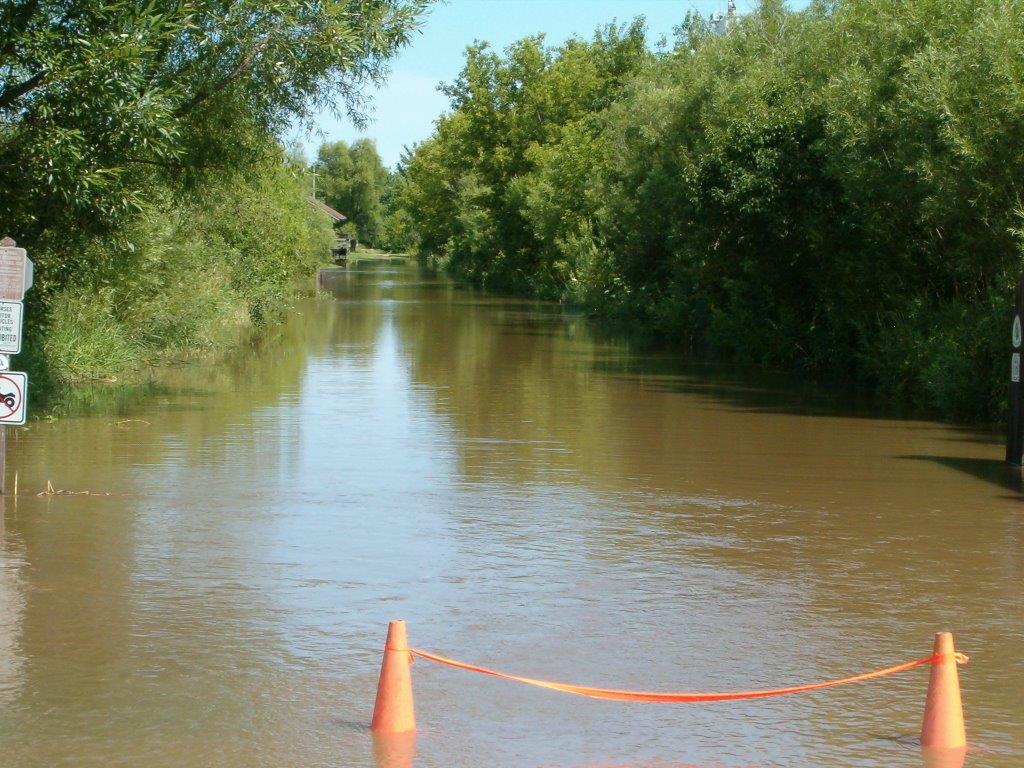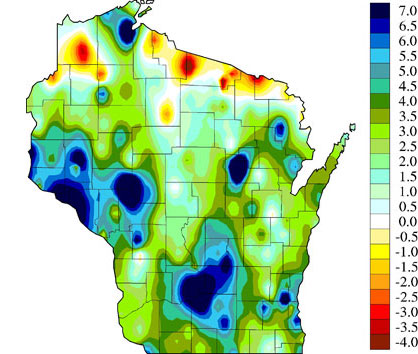Plague of Floods Caused by Climate Change
Dozens of 100-year floods in 30 years, roads keep getting washed out.
For starters, some perspective on the flooding problem in Wisconsin.
Many roads and other infrastructure washed out in 2016 floods are still not rebuilt; one official from northwestern Wisconsin says he has seen a dozen 100-year-storms in the last 30 years. In the same story a state official says road building standards have not caught up with “evidence…pointing towards increasing frequency of large” storm events:
The state upgraded culverts and made improvements where possible while trying to restore travel routes as quickly as possible last summer, said Gary Brunner, chief project development engineer with the Wisconsin Department of Transportation. And while making quick and quality repairs is crucial, Brunner said there is a need to look at how the state plans for storms like the one that ripped across northern Wisconsin.
“We do know that evidence is pointing towards increasing frequency of large events like this,” Brunner said. “I don’t think the standards have really caught up in terms of how we should try to design for the future, because you also have to think about how are we going to pay for designing for the future…”
Brunner said it would break the bank if every local government tried to engineer roads to withstand 500-year to 1,000-year flood events like last July’s flood. Many towns have struggled to pay for repairs just to return them to their condition before the storm. Some local governments who have finished work are still waiting to be paid.
Others have been raising alarm over the situation. State Sen. Kathleen Vinehout (D-Alma) said after the 2016 floods:
Repairing rural roads is a huge challenge for every town board. For many years, the state budget provided less money than towns needed to keep up with routine wear and tear on roads. With the recent floods, new problems appeared and old problems are worse.
Likewise, conservation structures – dams and so forth – were not built to handle the storms we experienced. Again, state support has lagged behind needs.
The US EPA has been raising the alarm since 2003 – – a warning to local officials I heard for myself – – and which I have repeatedly cited in stories:
Then-Milwaukee Mayor John Norquist and I attended a conference in Chicago in 2003, hosted by Mayor Richard Daley, where officials from the EPA told Midwestern elected leaders that climate change models predicted heavier rain events.
The EPA officials were urging the Midwestern leaders to adapt their planning and spending to more aggressively confront storm water and related services because heavier, intense rains were going to be come more frequent.
Part of the message was: forget the notion of the “100-year-storm.” They’ll come more often than that in the Midwest as the atmosphere warms.
Yet the Wisconsin DNR under Gov. Scott Walker has deleted climate change science and published data from its webpages, as I first reported, and the deleted information included explanations of how a warming climate will trip off more rain and flooding, including deletions like this:
Changes in rain and snowfall patterns (including more frequent and severe storms) could change water flow in streams and rivers and increase stream bank erosion and runoff pollution.
The evidence of climate change causing flooding keeps mounting:
–Flood emergency disaster declarations for 17 additional Wisconsin Counties brings the current total to 20, or nearly 30% of the state’s 72 counties.
–Western Wisconsin has again been hammered with storms since last summer’s road-and-bridge-breaking onslaught.
–Southern Wisconsin keeps getting soaked as both the days and nights heat up:
Thursday’s high in Madison was 87 at 4:01 p.m., 5 degrees above the normal high… Thursday’s low in Madison was 67 at 5:38 a.m., 6 degrees above the normal low…
For meteorological summer (June through August), Madison’s precipitation total rose to 11.4 inches, 4.09 inches above normal. The 2017 total rose to 27.06 inches, 7.92 inches above normal.
-An there’s the suffering Southeast:
-And 600 damaged properties just in Racine County a couple of days ago.
So are these so-called 100-year storm events, or more or less weekly Wisconsin happenings?
Well, don’t ask any of those science-types.
Because the state for ideological reasons has officially stopped recognizing the obvious implications of climate change and publishing such information on public sites.
But note how many of these issues were dealt with by a detailed, February, 2010 report, including data and charts showing:
Wisconsin has become warmer, especially at night, and wetter…
More frequent extreme precipitation events...
More warming at night…and more warming up north and away
from Lake Michigan
…issued by the highly-respected, science-based, data-driven Wisconsin Initiative on Climate Change Impacts, (WICCI) program.
From 1950 to 2006, Wisconsin as a whole has become wetter, with an increase in annual precipitation of 3.1 inches. This observed increase in annual precipitation has primarily occurred in southern and western Wisconsin, while northern Wisconsin has experienced some drying.
Yet Walker’s DNR Secretary Cathy Stepp has stepped away from the climate change initiative, according to the Lakeland Times newspaper last year:
…Stepp says the agency’s partnership with WICCI has come to an end.
The agency was heavily involved in the 2011 assessment by WICCI that still serves as the group’s benchmark, but Stepp says those days are long gone.
“That was a study that was done through a lot of different partners and the former DNR under the past administration was very involved in that,” she said. “We are not involved in that anymore.”
James Rowen, a former journalist and mayoral staffer in Milwaukee and Madison, writes a regular blog, The Political Environment.
Op-Ed
-
Wisconsin Candidates Decry Money in Politics, Plan to Raise Tons of It
 Dec 15th, 2025 by Ruth Conniff
Dec 15th, 2025 by Ruth Conniff
-
Trump Left Contraceptives to Rot; Women Pay the Price
 Dec 8th, 2025 by Dr. Shefaali Sharma
Dec 8th, 2025 by Dr. Shefaali Sharma
-
Why the Common Council’s Amended Budget is Good Policy for Milwaukee
 Nov 20th, 2025 by Alds. Marina Dimitrijevic and Russell W. Stamper, II
Nov 20th, 2025 by Alds. Marina Dimitrijevic and Russell W. Stamper, II





















